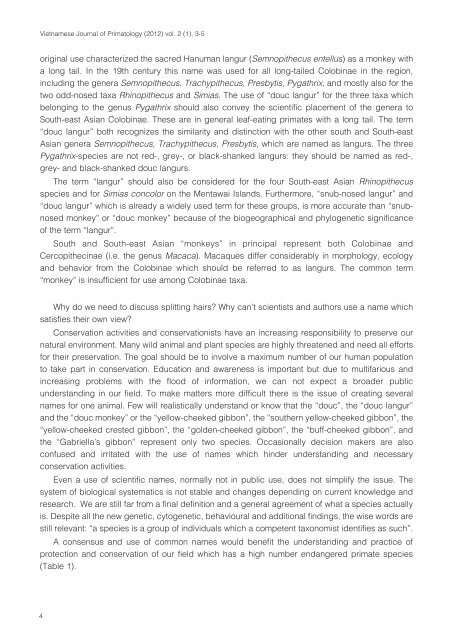Vietnamese Journal of Primatology (2012) - Frankfurt Zoological ...
Vietnamese Journal of Primatology (2012) - Frankfurt Zoological ...
Vietnamese Journal of Primatology (2012) - Frankfurt Zoological ...
Create successful ePaper yourself
Turn your PDF publications into a flip-book with our unique Google optimized e-Paper software.
<strong>Vietnamese</strong> <strong>Journal</strong> <strong>of</strong> <strong>Primatology</strong> (<strong>2012</strong>) vol. 2 (1), 3-5<br />
original use characterized the sacred Hanuman langur (Semnopithecus entellus) as a monkey with<br />
a long tail. In the 19th century this name was used for all long-tailed Colobinae in the region,<br />
including the genera Semnopithecus, Trachypithecus, Presbytis, Pygathrix, and mostly also for the<br />
two odd-nosed taxa Rhinopithecus and Simias. The use <strong>of</strong> “douc langur” for the three taxa which<br />
belonging to the genus Pygathrix should also convey the scientific placement <strong>of</strong> the genera to<br />
South-east Asian Colobinae. These are in general leaf-eating primates with a long tail. The term<br />
“douc langur” both recognizes the similarity and distinction with the other south and South-east<br />
Asian genera Semnopithecus, Trachypithecus, Presbytis, which are named as langurs. The three<br />
Pygathrix-species are not red-, grey-, or black-shanked langurs: they should be named as red-,<br />
grey- and black-shanked douc langurs.<br />
The term “langur” should also be considered for the four South-east Asian Rhinopithecus<br />
species and for Simias concolor on the Mentawai Islands. Furthermore, “snub-nosed langur” and<br />
“douc langur” which is already a widely used term for these groups, is more accurate than “snubnosed<br />
monkey” or “douc monkey” because <strong>of</strong> the biogeographical and phylogenetic significance<br />
<strong>of</strong> the term “langur”.<br />
South and South-east Asian “monkeys” in principal represent both Colobinae and<br />
Cercopithecinae (i.e. the genus Macaca). Macaques differ considerably in morphology, ecology<br />
and behavior from the Colobinae which should be referred to as langurs. The common term<br />
“monkey” is insufficient for use among Colobinae taxa.<br />
Why do we need to discuss splitting hairs? Why can’t scientists and authors use a name which<br />
satisfies their own view?<br />
Conservation activities and conservationists have an increasing responsibility to preserve our<br />
natural environment. Many wild animal and plant species are highly threatened and need all efforts<br />
for their preservation. The goal should be to involve a maximum number <strong>of</strong> our human population<br />
to take part in conservation. Education and awareness is important but due to multifarious and<br />
increasing problems with the flood <strong>of</strong> information, we can not expect a broader public<br />
understanding in our field. To make matters more difficult there is the issue <strong>of</strong> creating several<br />
names for one animal. Few will realistically understand or know that the “douc”, the “douc langur”<br />
and the “douc monkey” or the “yellow-cheeked gibbon”, the “southern yellow-cheeked gibbon”, the<br />
“yellow-cheeked crested gibbon”, the “golden-cheeked gibbon”, the “buff-cheeked gibbon”, and<br />
the “Gabriella’s gibbon” represent only two species. Occasionally decision makers are also<br />
confused and irritated with the use <strong>of</strong> names which hinder understanding and necessary<br />
conservation activities.<br />
Even a use <strong>of</strong> scientific names, normally not in public use, does not simplify the issue. The<br />
system <strong>of</strong> biological systematics is not stable and changes depending on current knowledge and<br />
research. We are still far from a final definition and a general agreement <strong>of</strong> what a species actually<br />
is. Despite all the new genetic, cytogenetic, behavioural and additional findings, the wise words are<br />
still relevant: “a species is a group <strong>of</strong> individuals which a competent taxonomist identifies as such”.<br />
A consensus and use <strong>of</strong> common names would benefit the understanding and practice <strong>of</strong><br />
protection and conservation <strong>of</strong> our field which has a high number endangered primate species<br />
(Table 1).<br />
4
















